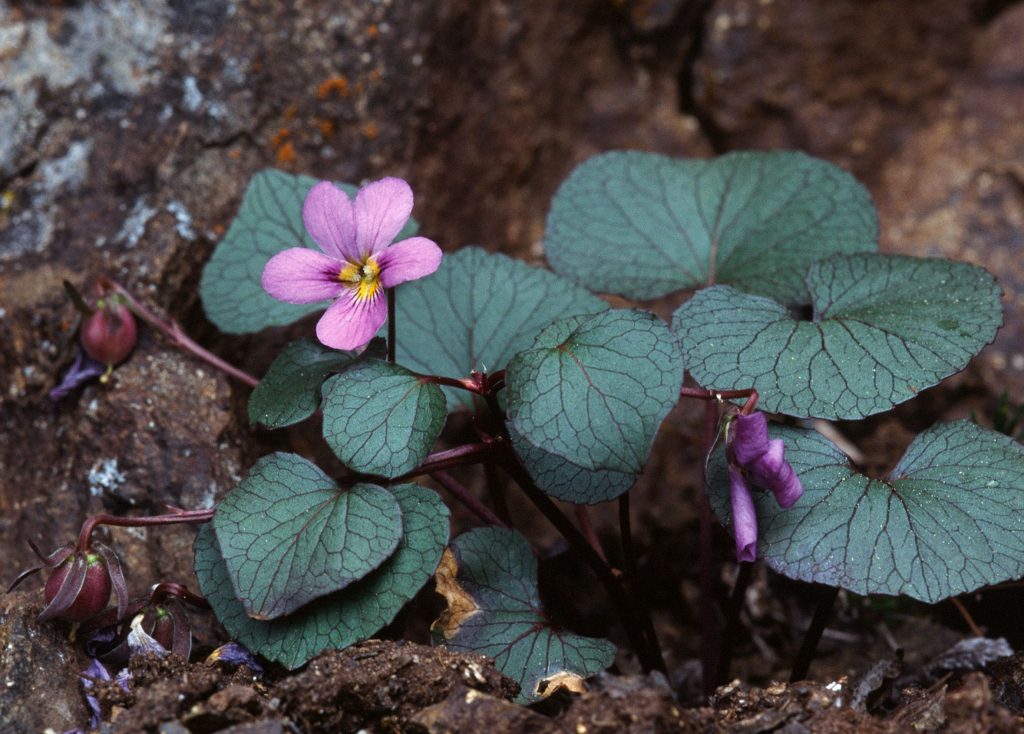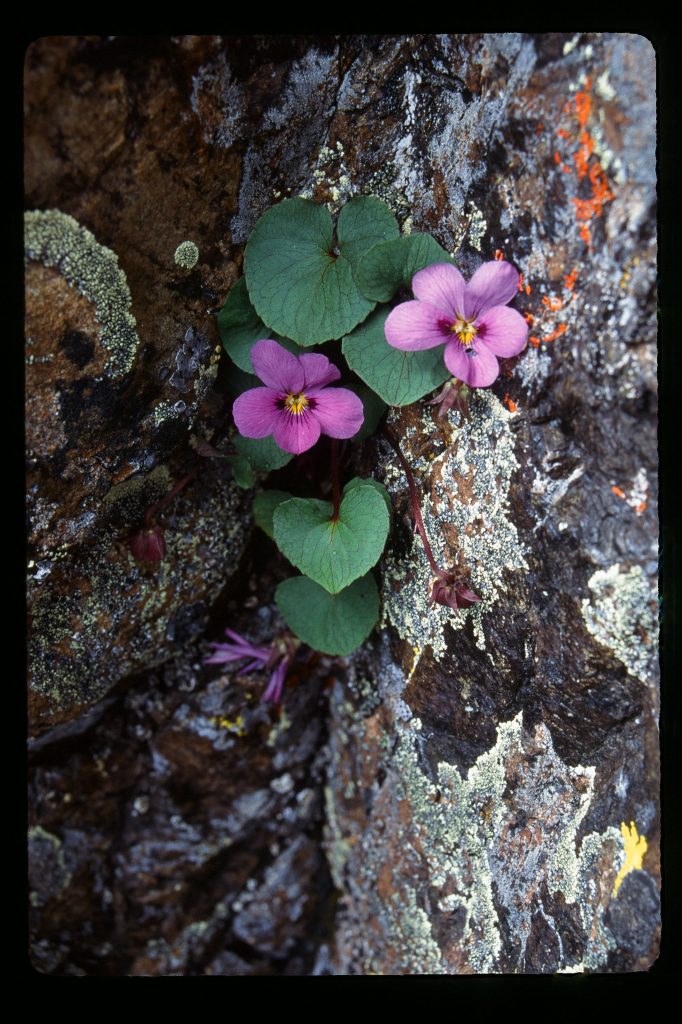Viola flettii Piper
Description. Illustrations: 3 photographs of Viola flettii and 2 drawings.

During two periods of glaciation in the last Ice Age, 18,000 and 15,000 years ago, most of the Olympic Peninsula in Washington State was covered by extensive glaciers. However the tops of the higher peaks on the eastern edge of the peninsula did not freeze, because they were in a rain shadow with warmer temperatures. These mountain tops became island refuges for several endemic plant species including Flett’s violet, Viola flettii. Evolving in isolation for thousands of years it developed such precise living requirements that it is unable to adapt elsewhere and, therefore, cultivation is also very difficult. Because of its very limited subalpine habitat, this glacial relict is a rare species.
Plants of V. flettii are less than 15 cm (6 inches) high; the lower half buried in the soil and rock crevices or talus; the rhizome is thick, horizontal or ascending, producing many long tough lateral roots. The whole plant is glabrous except for very occasional scattered minute hairs on the petioles, upper leaf veins or the sepals. There is a characteristic purple cast throughout the entire plant, the basal and cauline petioles and upright stems being dark purple. The leaves are glaucous with conspicuous purple veins, and purple colour on the under side and the flowers are purple. As is characteristic of all species of this subsection Canadenses, there is a bright yellow central throat and darker purple patches in the middle of the two lateral petals.

Petioles are 5-10 cm long. The thickish leaves are up to 4 cm broad, thick with regularly toothed margins. There is one basal leaf per stem, the basal leaves are broadly reniform to very widely ovate, tip truncate or obtusely pointed, basal lobes forming a deep sinus. Cauline leaves are smaller and broadly ovate, their base shallowly cordate, truncate to attenuate as leaves ascend the stem. The stipules are free, lanceolate, 0.5 cm long; older cauline stipules are scarious but newer stipules are purple with glandular-tipped fimbriae on their margins.
Flower peduncles arise from the axils of the cauline leaves; bracteoles are at the top of the peduncle, 0.4 cm long. Flowers 1.5-2.0 cm long and wide; petals are all wide, blue-purple/mauve (very rarely white), slightly darker purple on the reverse. The red-purple colour often seen in photographs is incorrect, an aberration of film. Hairs on the inside of the lateral petals are club-shaped, pale cream-coloured on the central yellow background; the end of the lowest petal is pointed. The petal spur is yellow, 1.0-1.25 mm long; ovary and style, 0.4 cm high, style with hairs on the sides and back of the head. Calyx 0.8 cm long; sepals glabrous or minutely puberulent, purple, with a blunt tip; auricles (sepal appendages) rounded to truncate, short, thick, 0.1 cm long. Flowering period July to Aug.

Seed pods are orbicular, green, spotted with purple, to dark purple, 0.7 cm long. The seeds are dark brown to brownish purple.
Occurring at the upper tree-line, 1371-1829 m (4500-6000 ft), V. flettii is growing in the seams and crevices of dark red basalt outcroppings of the crescent formation, and in loose talus at the base of the slopes. Lower plants are grazed by deer if they can get a foothold in the crumbling rocks.

Found only in the Olympic Mountains of the eastern Olympic Peninsula, Washington: Mt. Angeles, Mt. Constance and Mt. Elinor, the Devil’s Backbone, Dinosaur Ridge. The distribution of this violet is very limited by the availability of suitable rocky habitats in a narrow climate range.
Nomenclature and Taxonomy
Section Chamaemelanium Ging., subsection Canadenses (Marcussen, 2011).
Viola flettii Piper, C.V., Erythea 6:69 1898. Collected by J.B. Flett, 20 Jul 1897.
Base chromosome number (x) of subsection Canadenses is 6. Considering its age, V. flettii is most likely a diploid species, 2n=12. Studies of this subsection suggest an original coastal ancestor for the three narrowly distributed western species (V.cuneata, V. flettii, and V.ocellata) from which the Mexican and eastern species were derived (Ballard, pers. comm.).
